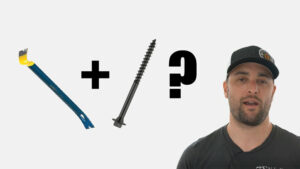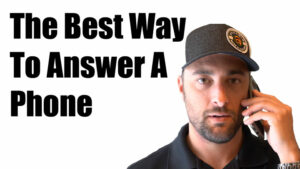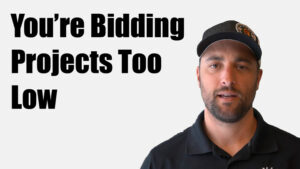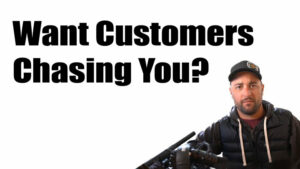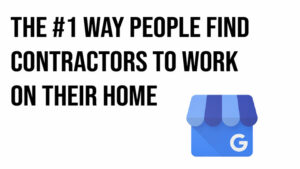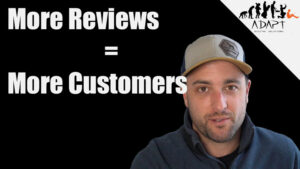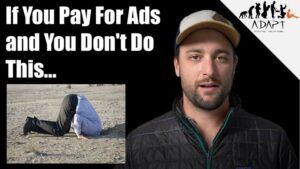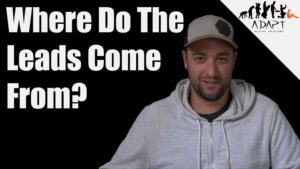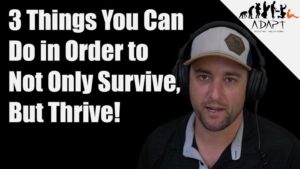What I Wish I Would Have Known When I First Started Down the Lead Generation Rabbit Hole
Six years ago when I googled the word “marketing” because I didn’t know what it meant, I literally knew nothing. Here I am years later and I’ve run marketing for dozens of companies around the country and have tried everything. I have seen things work and other things crash and burn. I put together this list for past Chuck. The guy that was just getting started 6 years ago and didn’t know a thing. This is the information I would have liked to have back then so I’m putting it together for you now.
This isn’t meant to be gospel. It’s my thoughts and opinions on these various channels of lead generation that I’ve seen work for landscapers. I’ve worked with companies in their infancy, others that have been around for a year or two, and some that are over 20 years old. The principles are the same across the board but where you are at in your journey will dictate what option you start with or which you think is most useful for you right now.
I go over this stuff in video format and in writing so you can digest this information as you please. The video will leave out things I say in writing and vise versa. Think of this content as inside information from someone who has spent the last 6 years in the trenches. As always, if you have questions, post them in one of the comment sections and I’ll help you get it sorted. If you like this article, hit the like button above and/or share it with people you think need it. Thanks!
What exactly is a lead?
In order for us to be on the same page, we have to be working with the same definitions so let’s define what I mean by lead since I’m going to be using the word hundreds of times in this article. When I say lead, what I mean is:
“Either a phone call or the contact information from someone who has expressed interest in becoming a paying customer.”
The typical order of operations is simple:
- Someone expresses interest in becoming a paying customer.
- You find out what they want and present them a price for delivering it.
- They either accept your offer, try to renegotiate, or refuse.
Step one is where lead generation comes into play. Step two and beyond is moving into sales territory so in this article, we’ll stick to the leads.
How I Will Compare the Different Types of Lead Generation
In order to make this actionable and useful for you, I’m going to use a 5-point scoring method. Let me quickly outline what each score means so you can breeze through this article and get the information you need. Each one will get a score from 1 to 10 with an explanation of why I graded it that way.
1. Volume
When I speak about volume, I’m referring to how many leads you can expect to get. For new or smaller companies, you might not need very much volume. My remodeling company, for example, only needs a handful of leads per month to stay busy as our projects can take 12+ months to go from beginning to end. For a landscaping business, it will depend on the type of services you’re focusing on. For a full-service landscaping company, you will want to generate leads for various types of jobs to keep your crews busy.
2. Lead Quality
Unfortunately not every lead that we get will actually turn into a sale. In fact, a lot of them won’t even get to step two. You’ll find that people might reach out to you and then change their mind and never even talk to you. This happens more from some lead sources than others, so I want to compare the various types based on my experience as a contractor and as the owner of a marketing company who works with landscapers and other contractors throughout the country.
3. Control
You might not think of this one at first, but the control you have over each channel will become increasingly important as you grow your business. If you don’t control the flow of new customers coming into your business, then you’re at the mercy of nature or other people. As the owner of multiple businesses I can tell you straight up that control is one of the most important aspects of the business.
4. Scalability
Scalability describes how big and broad a source can get. It’s similar to volume but more related to your ability to increase the volume if you want. It will make more sense later but this is a major factor for those trying to grow a business to $1million and beyond. In that case, you will need to be able to expand your lead generation efforts big time.
5. Cost and Profitability
How much something costs is always a center of concern for business owners. What is even more important is profitability. If you could spend $10 and get back $100, would you do it? Of course you would. In principle, if you could spend $100,000 to make $1,000,000, you would do it again. As cost can be a barrier to entry I’ll consider that as well as how profitable I’ve found each channel to be.
Note: If you have questions, there is a comment section below this article. If the question is too personal for a public platform, feel free to reach out to me directly at chuck@adaptdigitalsolutions.com.
Lead Generation Channels for Landscapers
At the beginning of a business venture, people typically start with the free options. Over time as they save money for marketing, they move into the investments that really speed things up. In order to sort of follow a normal business cycle, I’ll start with the beginner methods and then move into the more advanced ones.
Finding Landscaping Clients Through Your Personal Network
A commonplace to start for a new business is your personal network. Who do you know that might need your services? I know that the first web design client I got 5 years ago was because I knew someone that sat on the board of directors.
It’s common for people to post up on their Facebook that they have just started a landscaping business and are looking for new clients. Usually, you can get a few clients this way. It doesn’t hurt to ask everyone you know if they know anyone who needs consistent lawn mowing, snow removal, or other landscaping services. Even for seasoned businesses, it’s never wrong to offer your services to people you know.
-
Volume: 1/10
– You’re not likely to have a huge personal network but it should be enough leads to get some sales and get the money flowing into your bank account.
-
Lead Quality: 10/10
– People that already know you and need the services you offer should be very easy to work with. If you’re not able to close deals with these folks, then you’ll struggle with people who don’t know you.
-
Control: 8/10
– You can reach out to people you know but you can’t control how they will refer people to you. Since you’re the one instigating it, I still rank this high up there as you can make this happen with enough blood, sweat, and tears.
-
Scalability: 1/10
– This is not scalable. Once you tap out your personal network, you’ll have to find another place to look.
-
Cost and Profitability: 10/10
– This shouldn’t cost you any money unless you’re bribing people.
Going Door to Door to Find New Clients
In the old days, this was super common. These days, it’s less common. That’s why I think it’s a great place to start. If you are just starting your business and are working with a shoestring budget, then going door to door with a smile on your face and a stack of business cards should be on top of your list of lead generation methods to try.
Think about it this way. If you don’t already have a full schedule or say you have a half day’s worth of work, you could spend your free time going door to door in a neighborhood you want to work in. You get bonus points if you have a T-shirt with your logo on it and can be friendly to people.
You don’t have to be super salesy. Just knock on their door. Give them a nice smile and a greeting and let them know what services you provide and that you’re just getting started so you wanted to meet people in person. Ask them if they have anything that needs to be done. Even if they say no, as long as they aren’t giving you hateful eyes, give them a business card and ask them to keep you in mind.
I know someone that did this recently and made $1000 in one day. He didn’t even have to knock on that many doors. Just like I said earlier, if you can’t sell to people face to face, then you’ll struggle when it comes to less personal methods. I would be extremely surprised if you knocked on 100 doors and didn’t get at least enough jobs to make $1000. Shocked, really.
-
Volume: 1/10
– You won’t be able to cover much ground, but you will be marketing your business in the most personal way possible.
-
Lead Quality: 8/10
– If you are friendly and come off as professional, anyone who needs a landscaper is going to offer you a way to take their money. You’ll also know pretty quick whether or not it’s going to work out. This is huge as you’ll see later on when we talk about other methods of lead generation.
-
Control: 10/10
– You have 100% control over who you talk to and how you approach them. It doesn’t get any better than this for control.
-
Scalability: 3/10
– This is slightly scalable. If you have good success with this, you can hire more people to do this with you. If you can hit 100 houses per day, then 5 people can cover 5oo houses per day. That’s called linear scalability.
-
Cost and Profitability: 9/10
– It’s pretty cheap to get a shirt made, get a stack of business cards, and get on the shoe-leather express going door to door. I expect you can make a huge profit off of a $100 investment.
Getting Landscaping Customers Through Word of Mouth
If you ask 100 landscapers how they market their business, 50% of them will say all they do is word of mouth. It’s not actually something they do, it’s something that is done to them. Their customers refer other customers who refer other customers. If you are experiencing word-of-mouth abundance, then that’s a good sign you are making your customers very happy.
Back in 2008, my family’s remodeling company operated almost 100% from word of mouth. It was great! Until it wasn’t…
When the housing market collapsed and the economy tightened up, our flow of new customers went away. It was a demonstration of pure lack of control and led me to learn how to generate leads and new business through other means.
For every landscaping business word of mouth should be the main channel for new customers. If you don’t ever get referrals, try asking for them. If you still don’t get them, then find out why your customers aren’t referring you to their friends and family. You can also give them extra business cards and maybe even a fridge magnet. Remember those?
There are ways to get more word-of-mouth customers but that’s a topic for another article.
-
Volume: 3/10
– How many word-of-mouth leads you get depends on how big your network of happy customers is. It can eventually get to the point where you get more business than you can handle from word of mouth alone, but it takes years.
-
Lead Quality: 9/10
– Typically if someone calls you who was referred by a friend or family member, they probably aren’t reaching out to anyone else. They are going to go with you as long as you don’t show them any red flags. Be quick and courteous with them and you should get most of these deals.
-
Control: 3/10
– As my family realized in 2008, there’s not much control to be had over this method for the business owner. That said, you can take action to spur on more referrals which is why I didn’t rank this a 1. You can keep in touch with customers via phone, mail, email, etc., and ask them for referrals occasionally. You’ll also get more repeat business this way as a lot of people will forget you after a year or two. Ask a plumber… They get this a lot!
-
Scalability: 5/10
– This is scalable as your book of clients grows. If you have a network of 1000 happy customers who consistently hear from you then you will get a nice amount of referrals. Find ways to keep in contact with people and that can become your main marketing expense, which isn’t much.
-
Cost and Profitability: 10/10
– This is a very cheap method of getting new customers. You’re already doing the work so you might as well do a really good job and go the extra mile to make people happy. Don’t forget to ask for referrals and reviews. There’s no shame in promoting an awesome service!
Online Methods for Landscaper Lead Generation
We’ve covered the free offline methods for marketing and lead generation. Now, let’s talk about the fun stuff.
In general, online marketing offers a lot more scalability. A lot of folks rush into it, however, if you haven’t taken advantage of the methods I’ve already covered, you should take another look at those. Digital marketing takes serious investment and needs to be done right or you risk wasting a lot of time and money.
As a contractor, I taught myself how to perform online marketing. It took hundreds of hours before I produced any results. Looking back I don’t regret it because it led me to create my marketing company but for those of you who are not looking for another business and are going to stick with being a contractor, I highly recommend finding someone who knows what they’re doing and paying them to get it done quickly and right.
Having said that, I know a lot of you are the do-it-yourself type of people and will want to make a go at it yourself which is totally fine. You’ll be able to learn what’s going on and will most likely eventually choose to hire someone once you see how much work goes into it.
Okay, that’s my comment, now let’s get into it.
Your Portfolio Website: The Mothership of Your Online Lead Generation (Organic)
When I use the term organic, I mean that Google will show your website because it considers it relevant to the search. This is a common term for marketers and SEO’s. The alternative to organic is called paid traffic. Google Ads is an example of this which we’ll get into later.
I’ve been practicing online marketing for half a decade and I could talk for hours about the importance of a website. For the sake of brevity, I’m going to try and make this short. So, here goes: It’s really really really important.
People that hear about you, including referrals, are going to go to your website almost immediately to learn about who you are and what you can do. They will look at your pictures, read reviews, and look for red flags. Not having a website is a red flag for a lot of people. Also, having an unprofessional website is a red flag for a lot more people.
I use the term portfolio website because it doesn’t need to be complicated. It doesn’t need a blog or tons of pages. It just needs to clearly:
- Introduce you and your team
- Explain exactly what you do and the process for hiring you.
- Show evidence that you work with real clients and make them happy.
- Show pictures to prove you do nice-looking work.
- Give people an easy way to contact you.
If your website can achieve these 5 things, then you’re off to a great start.
Your website is not only for people though. It’s for search engines like Google. Google is a computer but it’s in charge of who finds your website when they search online. That’s why your website needs to be easily understood by a computer as well as the person. The art of doing this is called SEO, or Search Engine Optimization. I have videos on my Youtube Channel discussing this in more depth. Head over there if this is the part you’re trying to do yourself or you just want to learn more about it.
The last thing I’ll say is that your website is the center of your marketing. It’s where people and computers look to learn about your business. While it’s possible to have a good business without one, there’s no good reason to not have one. With a $5000 investment, you can get all you need to look professional, allow people to find you through Google, and allow them to make contact and become leads, all on a regular basis without further investment.
Remember the question: would you spend $10 to make $100? Well, with a website it’s: would you spend $5000 to make $500,000+ over the coming years? Of course, so don’t cheap out and get one that doesn’t actually bring in customers.
-
Volume: 7/10
– With a general website and no advertising, you can expect to get a moderate amount of leads. Our website at Kile Construction generates about 10-15 leads per month. Some of my clients get 30+ per month directly from their website.
-
Lead Quality: 9/10
– Typically leads that come through a website are pretty well qualified. They have already vetted you and know what you can do. They just want to know how much it’s going to cost and when you can do it. I would say 9/10 leads that come through the websites I manage will answer the phone and ~40% actually become projects. It will differ for your business.
-
Control: 8/10
– The best part about a website compared to other online lead generation assets is that you control 100% of what’s on it. This isn’t the case with Facebook, HomeAdvisor, Angie’s List, Yelp, etc. On those platforms, you must follow their rules and are at their mercy if they want to change them. Your website is your domain, literally.
-
Scalability: 7/10
– A website can be seen by thousands of people per month for a local landscaping business. If you cover a wide region then even more people can visit. As far as your personal time investment, it’s extremely scalable. You can spend almost 0 time on your website once it’s established and generate leads for years.
-
Cost and Profitability: 8/10
– A really good website takes a decent up-front investment. You can expect to invest about $5000 for a good website that will get results. The profitability is huge though. For example, our website at Kile Construction has brought in millions worth of work in the last 5 years. It’s just become one of the most profitable tools in our business.
Google Maps: The Kind of Local Landscaper Lead Generation (Organic)
Starting in 2015, Google made it so only the top 3 businesses would show up at the top of Google Search. In the industry, we call this the 3-pack. Getting your business to show up in this 3-pack for people searching for your services can result in 100’s of phone calls per month.
It’s free to sign up. You can do so at google.com/business. If you are rushing to do this, the first search for your business and make sure there isn’t already a listing. Sometimes Google creates them automatically. You can claim this listing instead of creating a new one. I wrote a whole guide on this. You can download the pdf for free here.
Get the Google Maps Guidebook
It’s easy to get the listing live. It’s also not too difficult to get reviews. Just ask your happy customers. The hard part is getting it to show up in the top 3. If you have a lot of competitors, the challenge grows. Don’t worry, I’m going to tell you how.
The answer lies in your website. Google looks at your website to understand your business. If your website has good SEO, then it will translate into making your Google Maps listing show up higher. If it’s better than your competitors, you’ll show up first. It’s all about beating your competitors.
If you have a website and a Google Maps listing but it’s not showing up in the top 3, let me know and I’ll take a look and let you know some things you might try to get it to get there.
The bottom line: If it shows up in those top 3 spots, you will get phone calls and more website visitors.
-
Volume: 7/10
– Some listings get a few calls a week, others get dozens per week. It depends on how many searches are happening in your area. Some of my landscaper clients get dozens of calls per month directly from Google Maps.
-
Lead Quality: 8/10
– Typically leads that come through Google Maps are great. They most likely read your reviews before they called so they already decided you’re trustworthy. Since most of these leads are calls, it’s not hard to get them on the phone!
-
Control: 6/10
– You can control what you put on the listing and how much time, money, or effort you put into making it show up in the top 3, but you can’t control the format or the policies. Google decides what kind of information you can put on there and has the right to change it anytime. The positive side of this is that they don’t charge for it, so it won’t go away if you stop paying like other online listings like HomeAdvisor.
-
Scalability: 8/10
– While you have the opportunity to be found by everyone who searches for your services on Google (95% of people), you are limited to your immediate area. It’s very difficult to show up in the top 3 in the next town over. If it stopped there, I would give it a 6. I give it an 8, however, because you can get multiple listings. You can’t use PO boxes, but you can use other addresses where you could receive mail and hide the address to the public so nobody can see it. It’s common to have multiple listings in multiple cities to get more exposure.
-
Cost and Profitability: 10/10
– When we put together a website we include Google Maps as a part of it. Since they go together like peanut butter and jelly there’s no reason to do one without the other. I know some marketing agencies charge 1000’s per month to manage a listing and make it rank well, but for most of our clients, the initial setup with their website for ~$5000 is enough to get them showing up and getting calls. It mostly depends on your competition. Rural businesses do a lot better because there’s less competition. Like our website at Kile Construction, our Google Maps listing has brought in millions worth of work over the last 5 years.
Google Ads (Used to be Adwords): The Pay to Play Google Game
Since almost everyone that uses the internet to find a landscaper is using Google, I talk about Google a lot. If your website and Google Maps listing are put together properly, people will find you on Google. It can take time to see that happen, however. A brand new website can take 6 months before Google will show it on the first page. It’s just a rule they have. Google Maps can be quicker, but there’s no guarantee.
What is guaranteed is Google Ads. You can pay Google and they will put you right at the top of the search page for whatever keywords you want. You can go from nowhere to the top of Google Search in a matter of hours. The catch? It’s freakin expensive!
It works on a bidding system. That means if someone else is bidding $10 for a click, you have to pay $10.01 to show up above them. There’s more to it than that, but in a nutshell, that’s it.
The downside of this is that the competition is thick and the quality is low. Google will show your website in Google Maps and organic search if it is really good. This keeps the quality high and is why almost everyone uses Google. This isn’t the case for Google Ads. Anyone can slap together a crappy website and pay Google to put it at the top of the page. The low quality brings all sorts of unexpected results.
For one, the lead quality of people that come through ads is much worse than organic. I think part of the reason is that people aren’t finding you on their own. You’re asserting yourself by paying Google and so people didn’t vet you or choose you. When they find you through Google Maps or browsing your website, they feel like they found you on their own and value it more. It’s a psychological thing.
The point is that I’ve noticed ~50% lead quality from paid search compared to organic. It’s just the way it is. You pay a price for quick results and it’s not just money but time and effort during the sales process.
-
Volume: 9/10
– In most cases, the ceiling is pretty high for lead volume through Google Ads. This is because you can assert yourself in any search you choose. While you might only rank for 10% of the keywords organically, you can pay to show up for 100% of them.
-
Lead Quality: 5/10
– I’ve found that I get more people not answering the phone when I call from ads vs. organic channels. There are spambots and other riffraff as well. It’s still good enough that people pay Google over $1trillion per year so it obviously works.
-
Control: 9/10
– You get quite a bit of control with ads. You can choose to show up for any search keywords you want and can adjust your bids to show up on the top of the page or the bottom, depending on how much you want to spend. You can also send people to any webpage you want. The only reason I didn’t give it a 10 is that Google has policies and terms of service that you must abide by. If you don’t, you don’t get to play.
-
Scalability: 10/10
– Ads are very scalable. If you can make it work in one town, then you can make it work in the next town. Once you find something that works, you can repeat it over and over again.
-
Cost and Profitability: 5/10
– It’s expensive. There’s no getting around that. I’ve seen painters in Portland, Oregon paying $180 per click. That’s not per lead. That’s per click! If it takes 10 clicks to get a lead, you’re spending $1800 per lead! That’s insane. This is balanced out by profitability. If someone is spending that much for very long, then they either have loads of cash to burn or they’ve figured out a way to make a profit on it. This is why Google Ads will always eventually reach the point of non-profitability for most companies. If someone else has cheaper labor, cheaper materials, etc. then they will be able to pay more for clicks than you and still be profitable. This is why Google Ads is rarely my first choice. Speed is the main benefit.
Buying Landscaping Leads from HomeAdvisor, Angie’s List, Houzz, Porch, Yelp, Etc.
Let me be straight with you. This is probably my least favorite way to generate leads. These companies stay in business by monopolizing the first page of Google. That’s all they do. If you do a search for a “landscaper near me”, chances are you will see 10 lead reselling companies for every landscaping company. I think this is atrocious and reprehensible. These companies are middlemen who have weaseled in between contractors and their customers.
Now that I got that out of the way, it’s not all bad. I do have one or two clients that are able to make a profit on leads from HomeAdvisor. They do very high volume and cover a huge region. The leads are also pretty cheap, like $15 a piece. Most companies are paying $40+ per lead. When only 1 out of 7 of them answers the phone, that is very expensive.
I’ve talked to hundreds of contractors who have gone broke using HomeAdvisor. That’s why I don’t like them. Understanding what I know about how Google works, I realize that if more landscapers figured it out and got their own website and Google Maps listing to show up, these companies would start to go away. That’s my dream.
I’ll leave it with this. If you already get leads from all of the other channels and you still need more, then it’s time to consider buying leads from one of these companies. The only other time I would consider it is if you really want to burn cash and get frustrated.
-
Volume: 9/10
– You may be able to get a lot of leads. My customers tell me that 1 out of 7 of them, on average, actually answer the phone. HomeAdvisor sells leads to 6 contractors at a time. Keep that in mind. You need to call people the second you get their contact info.
-
Lead Quality: 2/10
– 1 out of 7 answers the phone. Need I say more? Okay, I will. My family used to use HomeAdvisor about 10 years ago. Back then it wasn’t so expensive and the lead quality was higher. We still had a lot of weird stuff happen like other contractors filling out the form to get a quote so they would know how to price a project… We also had a lot of homeowners request a quote just to compare it to one they already had. We wasted a lot of time on these leads. It was also a nightmare to terminate our service but that’s another story.
-
Control: 3/10
– You can control what’s on your profile and you can ask for reviews. Other than that, HomeAdvisor is in the driver’s seat. They can show or hide any reviews they want. They also are in control of the leads you get and when you get them. I already mentioned they send these to up to 6 landscapers at a time. Also, if you cancel your account, your reviews and profile can be erased. It’s not a great idea to rely on this service. It’s okay to use as an auxiliary method of lead generation.
-
Scalability: 8/10
– You can usually get more leads by paying more money so it’s pretty scalable.
-
Cost and Profitability: 2/10
– I would give it a 1 but occasionally I talk to someone that is able to turn a profit on these leads. For most, it’s not worth it. A sales team definitely helps. You need someone dedicated to calling these people the moment their contact info comes in. I can’t rank this any higher because of the hundreds of calls I get every year from people trying to sue these companies. It’s obviously not working for a lot of people and it’s putting them in a really bad spot and that pisses me off.
Content Marketing: Youtube, Blogs, Instagram, Etc for Landscaping Leads
These methods can work but they are a long game. If you already have enough customers and enjoy making content, then definitely do this. I wouldn’t consider this a great place to start, however.
The problem is that nobody will see your content, at least at first. If you are good at SEO, then you can get people to find your content eventually. You can also run ads to it. Youtube ads can work well if you know what you’re doing. They’re still relatively cheap.
For a landscaping company, these should be auxiliary methods of lead generation. You could even call it a hobby. If you make awesome videos, people will see them. Are they the people that will be hiring you to mow their lawn? Probably not. If you make local content, then maybe. You want possible customers to see it, not people on the other side of the country, right?
-
Volume: 1/10
– I don’t see this generating many leads. I haven’t met anyone who gets a lot of landscaping business this way. That doesn’t mean there aren’t a few out there!
-
Lead Quality: 8/10
– I imagine any leads that come through these methods will be pretty good. They watched or read your content. They know who you are and what you do. They trust you enough to contact you. That’s a good sign.
-
Control: 9/10
– You can make as much content as you want. You can also pay to advertise it. That’s a pretty high level of control. On your blog, you can say whatever you want. On Youtube, you can say anything you want as long as it doesn’t go against the mainstream narrative. In landscaping, I think you’re safe.
-
Scalability: 8/10
– Putting content online allows it to be seen by people all over the place. If you can figure out how to get 10 leads per month from your content, you should be able to 10x that. I would call that scalable.
-
Cost and Profitability: 7/10
– It’s cheap to write a blog. It can be cheap to make videos. Mostly this stuff takes a lot of time and effort. If you have an abundance of those things to spare, then these channels might be for you.
Offline Marketing and Lead Generation Methods for Landscapers
I might be an online marketer but I love offline marketing, a lot. T-shirts, hats, truck wraps, road signs, business cards. All these things should be a part of your routine once you get established. Your crew should all wear matching shirts with your logo and phone number on it. If they are humping dirt and doing a great job, people will notice and want them to do the same for them.
You drive your trucks everywhere. That’s cheap advertising. Everyone you talk to should get a business card. These are just little things that can really add up over time. Since you don’t have to go out of your way to do them, it’s a no-brainer.
-
Volume: 7/10
– Once this kind of strategy hits critical mass, it can bring in a lot of work. If you’re doing work on a busy road, that’s 1000’s of people per day passing your road sign, trucks, and crew wearing their shirts.
-
Lead Quality: 8/10
– If people see your number and call, they probably have a good reason for it. If your website is listed on the sign they see, then they will likely go there and vet you first. By the time they contact you they are already pre-qualified.
-
Control: 7/10
– You can control what people see and where they see it. That’s a lot of control. I don’t give it a 10 because you are limited by your location and can’t always control the circumstances. There will surely be moments when someone is doing something stupid with your brand shirt on and makes your company look unprofessional. It’s a double-edged sword. Just keep your guys in line.
-
Scalability: 6/10
– It’s not as scalable as online marketing by any means, but the bigger your company gets, the more crew members are out and about doing a good job, the more your brand will be seen. It can grow a lot over time the bigger you get. Strategically placed signs can be seen by tons of people.
-
Cost and Profitability: 8/10
– T-shirts, truck wraps, signs, etc. all cost money, but not that much. This is a part of doing business that will pay off big time if executed correctly.
Conclusion
Well, there you have it. That’s not every method, but it’s most of them. If you can capitalize on at least a few of these, you will do alright. Start on the one you think will be most effective and measure your results. Pay attention to the response you get so you can double down on what works and leave out what doesn’t work.
My company, Adapt Digital Solutions, provides the best marketing services for landscapers available. If you’re interested in learning more about what the means for you, get ahold of us, and let’s talk.
Good luck!





